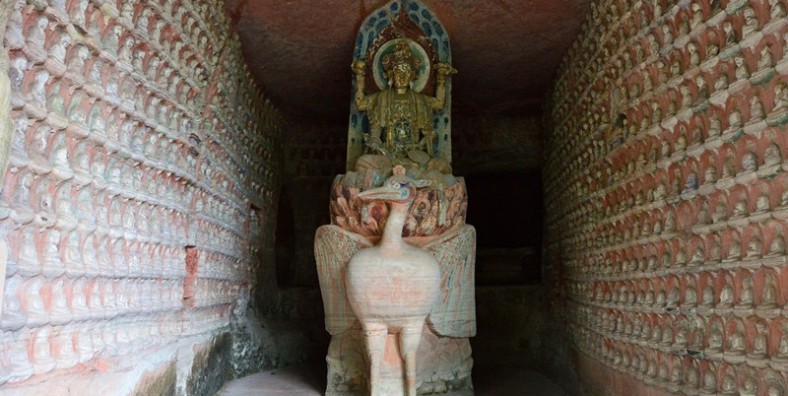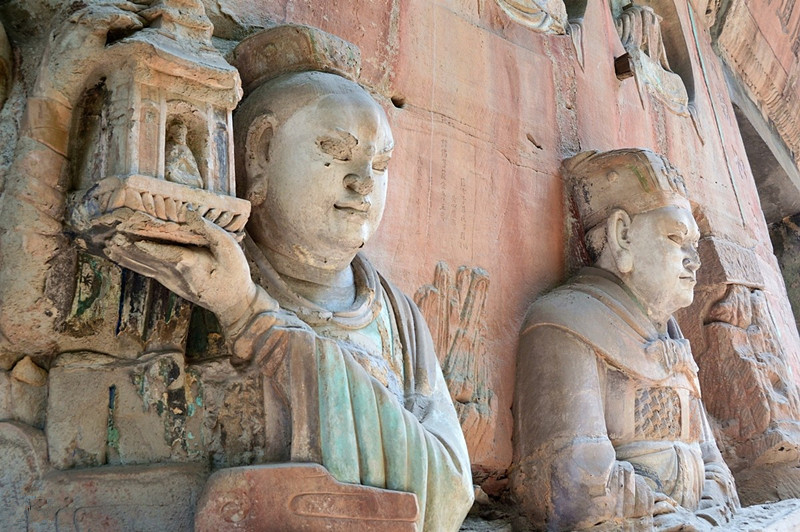
Dazu Rock Carvings in Chongqing

Covering figures and imagery taken from Buddhism, Taoism, and Confucianism the sprawling Dazu Rock Carvings are a series of cave sculpture temples clustered in central China that were built over thousands of years and catalogue huge portions of the country’s religious history with beautiful stonework.
English Name: Dazu Rock Carvings in Chongqing
Chinese Name:重庆大足石刻
Type: Ancient Ruins, Points of Interest & Landmarks, Sights & Landmarks
Opening Hours: 9:00-16:30 in Baodingshan 9:00-17:30 in Beishan
Admission Fee: March 1st ~ November 30th: Baodingshan: ¥135, Beishan: ¥90, joint ticket: ¥170 / December 1st ~ February 28th: Baodingshan: ¥110, Beishan: ¥70, joint ticket: ¥120
Recommended Visiting Hours: 3 ~ 6 hours
Season: All year round
Address: Dazu County, Chongqing
Dazu Rock Carvings
The Dazu Rock Carvings(Chinese: 大足石刻; pinyin: Dàzú Shíkè) are a series of Chinese religious sculptures and carvings located in Dazu District, Chongqing, China. The carvings date back as far as the 7th century AD, depicting and influenced by Buddhist, Confucian and Taoist beliefs. Some are in rock-cut cave shrines, in the usual Chinese Buddhist style, but many others are rock reliefs carved into the open rock faces.
Where is Dazu Rock Carvings
The Dazu Rock Carving is located in the southeast of the Sichuan Basin. Dazu Rock Carvings is a general designation of the stone statues distributed in 76 places in the whole Dazu County. The number of the stone statues amounts to 60,000.
- 271 kilometers away from the west of Chengdu
- 167 kilometers away from the east of Chongqing.
Introduction of Dazu Rock Carvings
World Heritage Site
Listed as a World Heritage Site, the Dazu Rock Carvings are made up of 75 protected sites containing some 50,000 statues, with over 100,000 Chinese characters forming inscriptions and epigraphs. The sites are located in Chongqing Municipality within the steep hillsides throughout Dazu County, located about 165 kilometers west of the urban area of Chongqing. The highlights of the rock grotto are found on Mount Baoding and Mount Beishan.
The carvings were listed as a World Heritage Site in 1999, citing “…their aesthetic quality, their rich diversity of subject matter, both secular and religious, and the light that they shed on everyday life in China during this period. They provide outstanding evidence of the harmonious synthesis of Buddhism, Taoism and Confucianism.”
History
The earliest carvings were begun in 650 AD during the early Tang dynasty, but the main period of their creation began in the late 9th century, when Wei Junjing, Prefect of Changzhou, pioneered the carvings on Mount Beishan, and his example was followed after the collapse of the Tang dynasty by local and gentry, monks and nuns, and ordinary people during the Five Dynasties and Ten Kingdoms period (907-65). In the 12th century, during the Song dynasty, a Buddhist monk named Zhao Zhifeng began work on the elaborate sculptures and carvings on Mount Baoding, dedicating 70 years of his life to the project.
Off-limits to visitors for many years, the carvings were opened to Chinese travelers in 1961 and foreign visitors in 1980. Until 1975, there was only a muddy path between the town of Dazu and the main cluster of carvings. The isolation helped keep the art unharmed during the massive anti-religious vandalism of the Cultural Revolution.
 Main Rock Carvings in Dazu
Main Rock Carvings in Dazu
- Baodingshan Rock Carving
Baodingshan Mountain is located 15 km away from northeast of Dazu County, Chongqing. The Baodingshan Rock Carving was carved during 1174 – 1252, designed and organized by Zhao Zhifeng, a famous monk. The construction lasted over 70 years. It is a large Buddhist tantric dojo and also the essence of Dazu Rock Carving. Shengshou Temple is grand and majestic. It was originally built by Zhao Zhifeng in South Song Dynasty. - Beishan Rock Carving
Beishan Rock Carving is located 2 km away from north Dazu County, Chongqing. It started carving in 892 during Tang Dynasty and then from the Five Dynasties to South Song Dynasty. - Nanshan Rock Carving
Nanshan Rock Carving is located 2 km away from Dazu County, Chongqing. The Nanshan Mountain (South Mountain) had been reputed as one of the ten scenes of Dazu since ancient time. Now, the Jade Emperor Temple is still preserved well on the top of the mountain.
How to Get There
It’s the most convenient to take a bus from Chongqing to Dazu. It just takes 2 hours to arrive there. There are tens of buses in the Chongqing West Bus Station.
- By Bus
If tourists who flying to Chongqing, in the Jiangbei airport there is a long distance bus, the bus directly go to the Dazu county, just only two shifts every day in the 12:30 and 17:30 respectively. The fare is 58 yuan. In Caiyuanba and Chenjiaping long-distance bus station there are buses going to Dazu county, basically half an hour for a bus. RMB 53 (buying from Caiyuanba station), going from Chenjiaping, the fare is about 52 Yuan. - By Taxi
If you don’t want to take bus you can also take taxi in the Dazu county. Not to hail a taxi around the old bus station, because the drivers may overcharge from customers. Normally taking taxi to Baoding town from Dazu county is 30 Yuan.
Useful Travel Tips
- Baodingsan Rock Carvings is the essence among Dazu Rock Carvings, and the transportation to it is the most convenient. However, it’s the farthest one to Dazu.
- The scenic area is not large, yet it’s crowded with tourists, and the most famous Thousand-Hand Kwan-yin was already repaired and is now open to the public.
- From the entrance to the attractions, there is a half hour walk. For those want to save some energy, you can take the battery car at the entrance, and the ticket is ¥20/person.
- Beishan Rock Carvings is very close to Dazu, and after finishing Baodingshan tour, you can take bus back to Dazu, then take a taxi to Beishan.
- The essence of Beishan is No.125 grotto and No.136 grotto.
Main Attractions in Chongqing
- Zhuoshui Ancient Town in Qianjiang District
- E’ling Park (Goose Neck Park) in Chongqing
- Three Gorges Museum in Chongqing
- Ciqikou Ancient Town in Chongqing
- Ningchang Ancient Town in Wuxi County
- Kanggu Scenic Area in Chengkou County
- Longgang National Geopark in Yunyang County
- Huaxia Peony Garden in Dianjiang County
- Chiyou Jiuli City in Pengshui County
- Hong’an Ancient Town in Xiushan County
- Qianye Grassland in Shizhu County
- Taohuayuan Scenic Area in Youyang County
Edited by Lynette Fu/付云锐
 Main Rock Carvings in Dazu
Main Rock Carvings in Dazu












